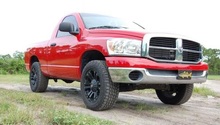Dodge Ram 1994-2001: Service and Parts Manuals
Get up to speed with your Dodge Ram 1500; read on to learn more about your truck's parts.
This article applies to the Dodge Ram 1500 (1994-2001).
If you own a second generation Dodge Ram 1500, the truth is it probably has a lot of wear and miles on it by now. The key to ensuring your truck is able to maintain most of its original components is through regular maintenance. Let's go through some of the information included in your service and parts manuals. This information is available to help you understand exactly what is happening underneath the hood of your truck.
Component Breakdown
Suspension
Your Dodge Ram 1500 is made up of a variety of components. Let's check out the major groups, starting with the front suspension and drive, which we'll call Group A. Within Group A, there is your front suspension, front axle drive shafts, front axle housing, front axle assembly, front axle disconnect and front axle differential. Together, these components ensure your truck handles well both on and off road, allowing you to control the steering wheel with ease and offer a safe and comfortable ride to you and your passengers.

Brake Lever and Cables
The next group is Group B, and it consists of your parking brake lever and cables. These components work together to prevent your truck from rolling away into traffic when you are parked on an uneven or hilly surface.
Note
While some forum members have never used the parking brake lever and haven't experienced issues, it is still important to use the parking brake at least once a month, or during colder days. Even if parking on level surface, using your parking brake lever will keep parts from rusting or seizing.

Service Brakes
This next group, which we'll refer to as Group C, involves your service brakes and consists of 7 components:
- Front brakes
- Rear brakes
- Power brake booster
- Brake master cylinder
- Brake lines and hoses
- Brake pedals
- Vacuum pump
If any of the above-mentioned components become faulty, you'll need to have them serviced immediately. It's recommended that you contact a local dealership; however, any certified automotive mechanic can run diagnostics on your truck and render any needed repair work. Brakes should be checked by a mechanic every 30,000 miles.
Clutch
This fourth group, Group D, is an important one because it involves your clutch. Your clutch makes it possible for your truck's engine and transmission to work in tandem as one. This group consists of several minor components, namely clutch controls and clutch pedals. The entire assembly must work together. If you ever have trouble shifting, the likely culprit is a bad clutch.

Cooling
This final group, although there are many more that can be found within your Dodge Ram 1500, is known as your cooling system, and it consists of about 7 main components:
- Radiator and related parts
- Water pump and related parts
- Coolant tank
- Drive belts
- Transmission oil cooler lines
- Grille and related parts
These components work together to ensure your engine oil does not overheat, which could spell big trouble for your engine. If you frequently use your truck to tow heavy cargo loads, you'll want to pay special attention to your cooling system, replacing your oil cooler lines whenever they start to leak.

Scheduled Maintenance
Whether you've racked up 100,000 miles on your truck or are slowly approaching this driving milestone, you'll want to pay special attention to your major systems, including your electrical system. Have a mechanic inspect your relays, sensors and modules, spark plugs, engine, and instrument panel-related wiring as well as your battery and alternator for signs of damage. Replace as needed. Change your engine oil every 3,000 miles and your engine filter every 12,000 miles.
For more information on the Dodge Ram's scheduled maintenance, check out this website: OpenBay.com
Common Questions
Where is my vehicle identification number (VIN) located?
Your VIN is located in your door jamb as well as on the base of your windshield.
Where can I purchase replacement service manuals?
Visit a local Dodge Ram dealership or see the related discussions section of this guide.
Common Issues
Transmission Replacement
While in many cases a transmission flush can resolve noise and performance problems, in other cases you may need an actual transmission replacement. Have a transmission flush every 30,000 miles. If you experience a lag in your transmission or notice the smell of burned gas, seek immediate professional assistance, as you might need to consider purchasing a new truck.
Battery Replacement
Count yourself lucky if your battery lasts for four years. In most cases, you'll need to have your battery changed out every couple of years.
Related Discussions
- Dodge Ram Service Manuals - Dodgeforum.com
- Dodge Ram Service Manual and Parts Manual - Dodgeforum.com






